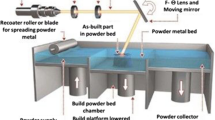Abstract
The metal additive manufacturing technology, with its savings in production time and the provision for expansive design capabilities has shown promise in the aerospace industry. Aerospace components have a critical need to be manufactured to endure in-service conditions, which includes durability when subject to variations in cyclic stress/strain loading histories including tensile mean stresses. Pulsating cyclic stresses in the tensile regime have proven detrimental to fatigue life, as they are prone to enhancing the rapid propagation of fatigue cracks. With this consideration, the current study has modeled the experimental fatigue performance of as-built additively manufactured stainless steel (SS) GP1 alloy, when subjected to progressive increases in cyclic strain range loads from Δε = 0.6% to Δε = 1.4%, and pulsating tension fatigue conditions. This is the first study to experimentally capture the cyclic stress–strain curve exhibited by stainless steel GP1 and to use the Chaboche model to model the hysteresis deformation response at varying strain amplitudes, providing a set of optimized Chaboche constants effective in capturing the kinematic/isotropic hardening behavior of this material under progressive amplitude fatigue and pulsating tension fatigue conditions.









Similar content being viewed by others
References
R.I. Stephens, A. Fatemi, R.R. Stephens, and O.H. Fuchs, Metal Fatigue in Engineering (John Wiley & Sons Inc., New York, 2001)
A. Yadollahi, N. Shamsaei, S. Thompson, A. Elwany, and L. Bian, Int. J. Fatigue 94, 218 https://doi.org/10.1016/j.ijfatigue.2016.03.014 (2017)
L. Carneiro, B. Jalalahmadi, A. Ashtekar, and Y. Jiang, Int. J. Fatigue 123, 22 (2019)
T.M. Mower and M.J. Long, Mater. Sci. Eng. A 651, 198 (2016)
J.M. Linares, J. Chaves-Jacob, Q. Lopez, and J.M. Sprauel, Rapid Prototyp. J. 28, 1182 (2022)
S. Sarkar, C.S. Kumar, and A.K. Nath, Add. Manuf. https://doi.org/10.1016/j.addma.2018.10.044 (2018)
Y. Wang, W. Wang, and L. Susmel, Int. J. Fatigue 152, 106412 (2021)
R. Molaei and A. Fatemi, Int. J. Fatigue 145, 106002 (2021)
B.M. Schonbauer, M. Fitzka, U. Karr, and H. Mayer, Int. J. Fatigue 142, 105963 (2021)
S.F. Siddiqui, K. Rivera, I. Ruiz-Candelario, and A.P. Gordon, Progressive Amplitude Fatigue Performance of Additively Manufactured Stainless Steel Superalloy. Paper presented at the TMS 2021 150th Annual Meeting and Exhibition (2021)
S.F. Siddiqui, Characterization of Anisotropic Mechanical Performance of As-Built Additively Manufactured Metals, (Ph.D. Dissertation, University of Central Florida, 2018)
S.F. Siddiqui, N. O’Nora, A. A. Fasoro, and A.P. Gordon, Modeling the influence of build orientation on the monotonic and cyclic response of additively manufactured stainless steel GP1/17-4PH. Presented at the ASME 2017 International Mechanical Engineering Congress & Exposition, Tampa, Florida, 3–9 November 2017
A. Polishetty and G. Littlefair, Int. J. Mater. Mech. Manuf. 7(2), 114 (2019)
W. Macek, R.F. Martins, R. Branco, Z. Marciniak, M. Szala, and S. Wronski, Int. J. Fract. 235, 79 (2022)
R. Halama, M. Pagac, Z. Paska, P. Pavlicek, and X. Chen, Ratcheting Behavior of 3D Printed and Conventionally Produced SS316L Material. Paper presented at the ASME 2019 Pressure Vessels & Piping Conference, San Antonio, Texas, 14–19 June 2019
J. Chaboche, Int. J. Plast 5, 247 (1989)
P.J. Armstrong and C.O. Frederick, A Mathematical Representation of the Multiaxial Bauschinger Effect, vol 731 (Berkeley Nuclear Laboratories, Berkeley, CA, 1966)
N.R. O’Nora, Compendium of Thermoviscoplasticity Modeling Parameters for Materials Under Non-Isothermal Fatigue (Honors in the Major in Mechanical Engineering, Bachelors Thesis, University of Central Florida, 2015)
J. Chaboche, Int. J. Plast. 24, 1642 (2008)
S.F. Siddiqui, A.A. Fasoro, and A.P. Gordon, Selective laser melting (SLM) of Ni-based superalloys - a mechanics of materials review, in Additive Manufacturing Handbook: Product Development for the Defense Industry. ed. by A.B. Badiru, V.V. Valencia, and D. Liu (CRC Press, Boca Raton, 2017)
B. Clausen, D.W. Brown, J.S. Carpenter, K.D. Clarke, A.J. Clarke, S.C. Vogel, J.D. Bernardin, D. Spernjak, and J.M. Thompson, Mater. Sci. Eng. A 696, 331 https://doi.org/10.1016/j.msea.2017.04.081 (2017)
W.E. Luecke, and J.A. Slotwinski, J. Res. Nat. Inst. Stand. Technol. 119, 398 (2014)
L. Facchini, N. Vicente, I. Lonardelli, E. Magalini, P. Robotti, and A. Molinari, Adv. Eng. Mater. 12(3), 184 (2010)
S.F. Siddiqui, A.A. Fasoro, C. Cole, and A.P. Gordon, J. Eng. Mater. Technol. 141(3), 031009 (2019)
Rohatgi, A. (2021). WebPlotDigitizer (4.5) https://automeris.io/WebPlotDigitizer
Acknowledgements
This work was supported by the National Science Foundation Graduate Research Fellowship Program under Grant No. 1144246, awarded to Sanna Siddiqui. The authors would like to thank Dr. Abiodun A. Fasoro for additively manufacturing the stainless steel GP1 specimens used in this study, which were developed using the EOS M280 system in the Manufacturing Engineering Department at Central State University. The authors would also like to acknowledge assistance in data analysis by Ms. Krystal Rivera, an undergraduate student at Florida Polytechnic University.
Author information
Authors and Affiliations
Corresponding author
Ethics declarations
Conflict of interest
On behalf of all authors, the corresponding author states that there are no conflicts of interest.
Additional information
Publisher's Note
Springer Nature remains neutral with regard to jurisdictional claims in published maps and institutional affiliations.
Rights and permissions
Springer Nature or its licensor (e.g. a society or other partner) holds exclusive rights to this article under a publishing agreement with the author(s) or other rightsholder(s); author self-archiving of the accepted manuscript version of this article is solely governed by the terms of such publishing agreement and applicable law.
About this article
Cite this article
Siddiqui, S.F., O’Nora, N. & Gordon, A.P. Modeling the Progressive Amplitude and Pulsating Tension Fatigue Response of Laser-Powder Bed Fusion Stainless Steel GP1. JOM 75, 1902–1914 (2023). https://doi.org/10.1007/s11837-022-05656-8
Received:
Accepted:
Published:
Issue Date:
DOI: https://doi.org/10.1007/s11837-022-05656-8




